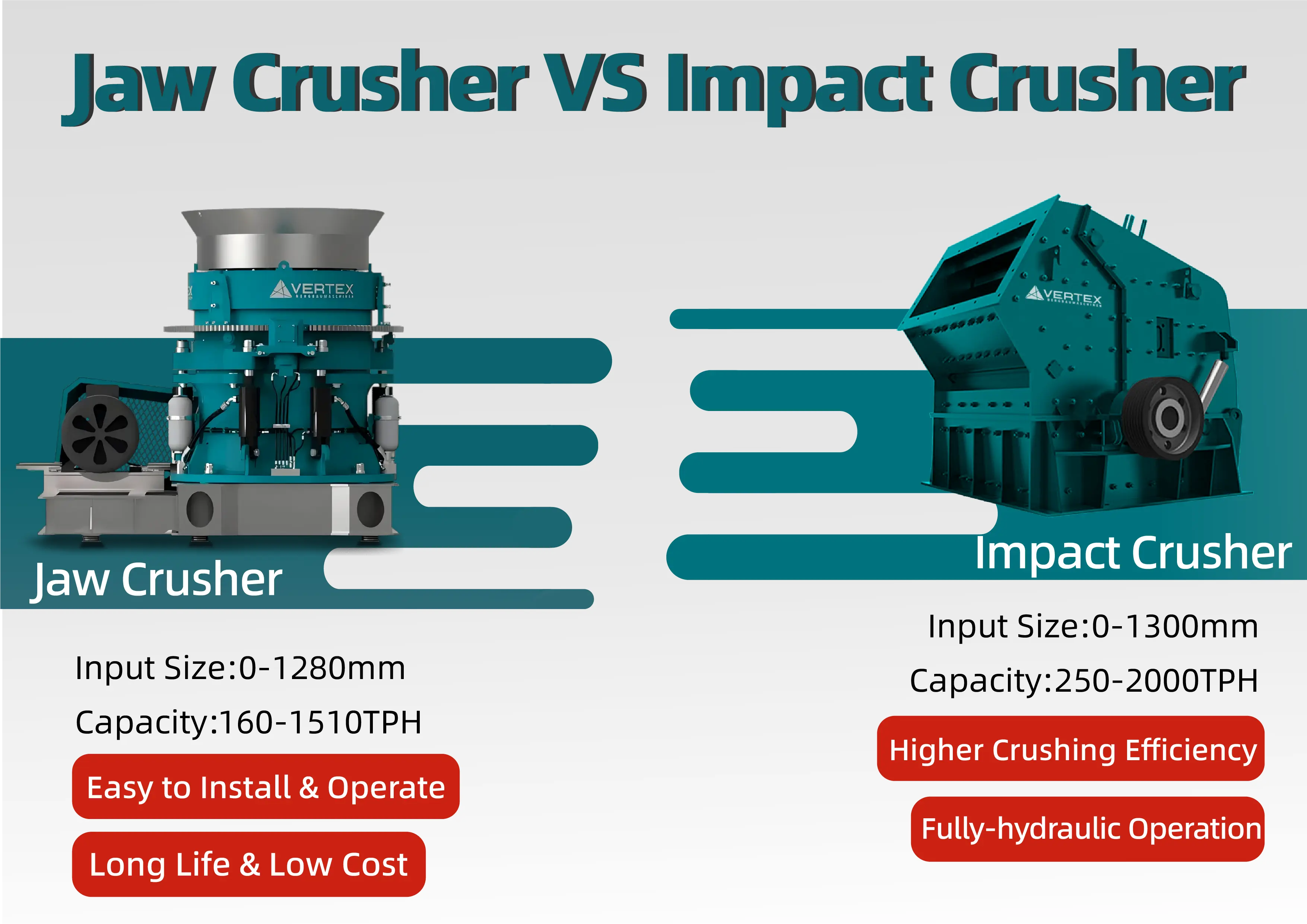
In the mining, construction, and recycling industries, crushing equipment serves as the core of operations. The choice between a jaw crusher and an impact crusher is often a crucial decision in process design. Although both machines can crush materials, their application scenarios, costs, and performance vary significantly. This article will conduct a comprehensive comparative analysis from 12 key dimensions to help you make the optimal choice.
Jaw crushers are well - known for their ability to handle materials with extremely high compressive strength. They can efficiently process materials with a compressive strength of up to 320 MPa. For instance, in large - scale granite quarries, granite, which has high hardness, can be easily broken down by jaw crushers. Basalt, another hard rock commonly used in high - grade road construction, is also suitable for initial crushing by jaw crushers. In iron ore mining, jaw crushers are often the first step in the processing line to reduce large - sized ore into more manageable pieces. Impact crushers are more suitable for materials with lower compressive strength, typically ≤150 MPa. Limestone, widely used in the cement industry, is an ideal material for impact crushers. Concrete waste from demolished buildings and recycled asphalt from old road surfaces can also be effectively processed by impact crushers. These crushers can break down relatively soft materials into smaller particles for reuse.
In the mining industry, jaw crushers are mainly used for primary crushing. After the ore is blasted in the mine, large chunks of rock need to be reduced in size. Jaw crushers can quickly handle these large - sized materials, making them suitable for the initial stage of the production line. Their large feed opening allows them to accept large rocks directly, which is crucial for high - volume mining operations. Impact crushers excel in aggregate shaping and construction waste recycling. In the production of high - quality aggregates for road bases, impact crushers can produce particles with a more cubical shape, which is beneficial for the stability and durability of the road. When it comes to recycling construction waste such as concrete and asphalt, impact crushers can break down the waste into reusable aggregates, reducing the need for new raw materials and promoting environmental sustainability.
It has a relatively simple structure, consisting of a fixed jaw, a moving jaw, an eccentric shaft, and a toggle plate. The fixed jaw is stationary, while the moving jaw moves back and forth under the action of the eccentric shaft. The toggle plate helps transfer the force from the eccentric shaft to the moving jaw, ensuring the smooth operation of the crusher. This simple structure makes the jaw crusher easy to manufacture, install, and maintain. The V - shaped crushing chamber of the jaw crusher is designed to optimize the crushing process. As the material enters the crushing chamber, it is gradually squeezed and crushed between the fixed and moving jaws. The V - shape design allows for a more efficient use of the crushing force, ensuring that the material is broken down effectively.
Compared to the jaw crusher, it has a more complex structure. It consists of a rotor, hammers or blow bars, and multiple impact aprons. The rotor rotates at a high speed, and the hammers or blow bars mounted on the rotor strike the material, causing it to break. The multiple impact aprons further enhance the crushing effect by allowing the material to rebound and be crushed multiple times. The multi - stage crushing chamber of the impact crusher enables the material to be subjected to repeated collisions. As the material enters the crushing chamber, it is first struck by the hammers on the rotor. Then, it rebounds off the impact aprons and is struck again. This multi - stage crushing process results in a finer and more uniform particle size.
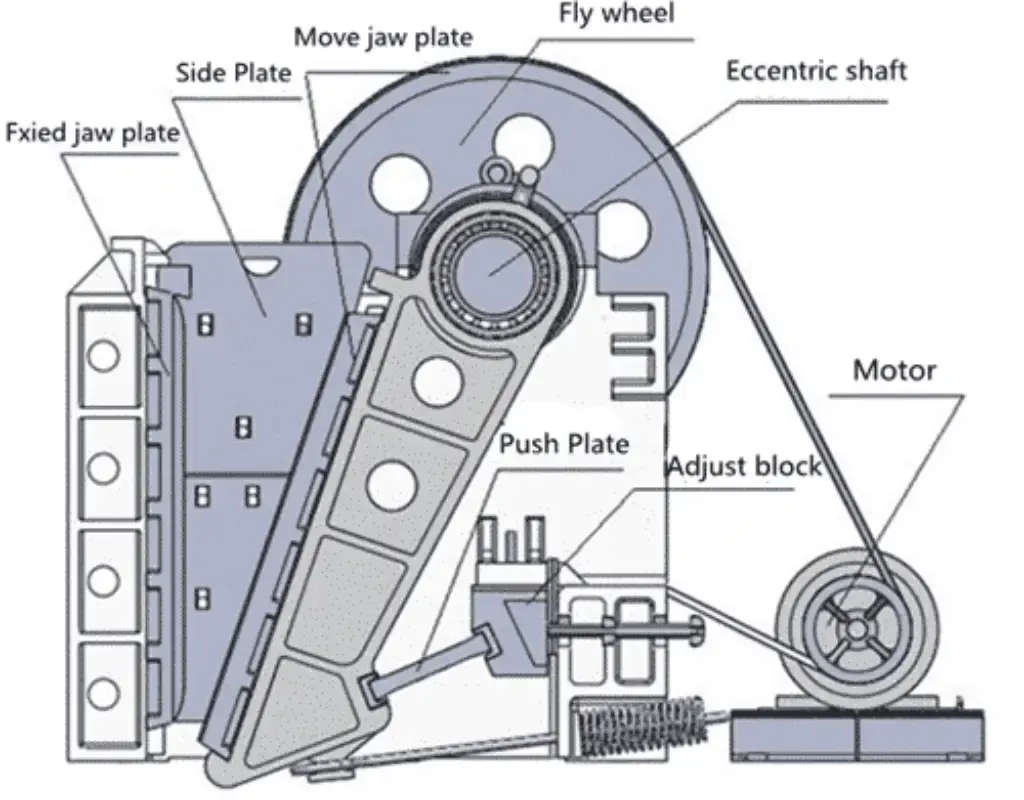
It operates on the principle of compressive crushing, mimicking the chewing motion of an animal. The moving jaw moves towards the fixed jaw, squeezing the material between them. The low - speed operation, typically between 250 - 400 revolutions per minute (RPM), allows for a controlled reduction of the particle size. This slow and steady crushing process is suitable for handling hard and brittle materials. The advantage of compressive crushing is that it is effective in breaking down large - sized materials. It can handle materials with high compressive strength without causing excessive wear on the crusher components. The simple design of the crushing mechanism also makes it reliable and easy to maintain.
It uses the principle of impact crushing. The rotor rotates at a high speed, typically between 500 - 1000 RPM, and hurls the material against the impact aprons. The high - speed impact causes the material to shatter upon collision. This free - impact principle is different from the gradual compression of the jaw crusher. The advantage of impact crushing is that it can produce a more cubical particle shape. The high - speed impact breaks the material along its natural fracture lines, resulting in particles with fewer sharp edges and a more regular shape. This is beneficial for applications where particle shape is important, such as in the production of high - quality aggregates for concrete.
It is typically used as the first step in the aggregate production line. It is responsible for reducing large - sized raw materials into smaller pieces. The large feed capacity of the jaw crusher allows it to handle the high - volume output from the quarry or mine. In addition, the performance of the jaw crusher can dictate the upstream drilling and blasting strategies. For example, if a jaw crusher has a large feed opening, larger - sized rocks can be blasted in the quarry, reducing the need for pre - sizing. As the primary crusher, the jaw crusher sets the foundation for the entire production line. Its efficiency and reliability directly affect the productivity and quality of the subsequent processing stages.
It is commonly used in the secondary and tertiary crushing stages. It processes the pre - crushed materials from the jaw crusher into saleable aggregates. The ability to produce a fine and uniform particle size makes the impact crusher suitable for final shaping and finishing. In a closed - circuit system, the impact crusher is often paired with a screen. The screen separates the particles of the desired size, and the oversized particles are returned to the impact crusher for further crushing, ensuring precise grading of the final product. The impact crusher plays a crucial role in improving the quality of the final product. By producing high - quality aggregates with a good particle shape, it can meet the strict requirements of various construction applications.
The throughput capacity of jaw crushers typically ranges from 1000 - 2200 tons per hour. However, this range can vary depending on several factors, such as the feed size, the hardness of the material, and the closed - side setting (CSS) of the crusher. In a large - scale mining operation, a high - capacity jaw crusher can process a significant amount of ore in a short period of time. The throughput capacity of impact crushers is generally in the range of 800 - 1500 tons per hour. Similar to the jaw crusher, the actual throughput capacity is affected by factors such as the rotor speed, the moisture content of the material, and the feed gradation. In a recycling plant, an impact crusher can process a large amount of construction waste efficiently.
The feed size is a critical factor affecting the throughput capacity of the jaw crusher. Larger feed sizes require more time and energy to break down, which can reduce the throughput. The hardness of the material also plays an important role. Harder materials are more difficult to crush, resulting in a lower throughput. The closed - side setting (CSS) determines the size of the discharge opening. A smaller CSS can produce finer particles but may also reduce the throughput. The rotor speed is a key factor for the impact crusher. A higher rotor speed can increase the impact force, resulting in a higher throughput. However, it also increases the wear on the hammers and impact aprons. The moisture content of the material can affect the crushing process. High - moisture materials may stick to the crusher components, reducing the throughput. The feed gradation, which refers to the distribution of particle sizes in the feed material, can also impact the performance of the impact crusher. A well - graded feed can improve the crushing efficiency and throughput.
It tends to produce particles with a higher flakiness index. The compressive crushing process can cause the material to break along its natural planes of weakness, resulting in particles with a more angular and elongated shape. The flakiness index of the particles produced by the jaw crusher is typically between 15 - 25%. While these particles are acceptable for applications such as drainage layers or railroad ballast, they may not be suitable for high - performance concrete or asphalt. In drainage layers, the flaky and needle - shaped particles can provide good permeability. In railroad ballast, the angular shape of the particles can interlock, providing stability to the railroad tracks.
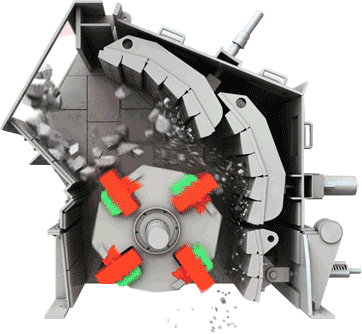
It is capable of producing particles with a high degree of cubical shape. The impact crushing principle breaks the material in a more random manner, resulting in particles with a more regular shape. The flakiness index of the particles produced by the impact crusher is typically ≤10%. These cubical particles are preferred for applications where particle shape is critical, such as in architectural precast elements and high - grade road surfaces. In architectural precast elements, the cubical particles can improve the workability and strength of the concrete. In high - grade road surfaces, the cubical particles can provide better interlocking, resulting in a more durable and stable road.
Jaw crushers are relatively energy - efficient when crushing hard rocks. The energy consumption of jaw crushers is typically in the range of 0.5 - 1.2 kWh per ton for hard rocks. The low - speed operation and the simple crushing mechanism contribute to the relatively low energy consumption. However, the energy consumption can increase when the crusher is operating at a high capacity or when processing very hard materials. Impact crushers generally have a higher energy demand. The high - speed rotation of the rotor requires a significant amount of energy. The energy consumption of impact crushers is typically in the range of 1.5 - 2.5 kWh per ton. This higher energy consumption is due to the need to generate a high - speed impact force to break the material.
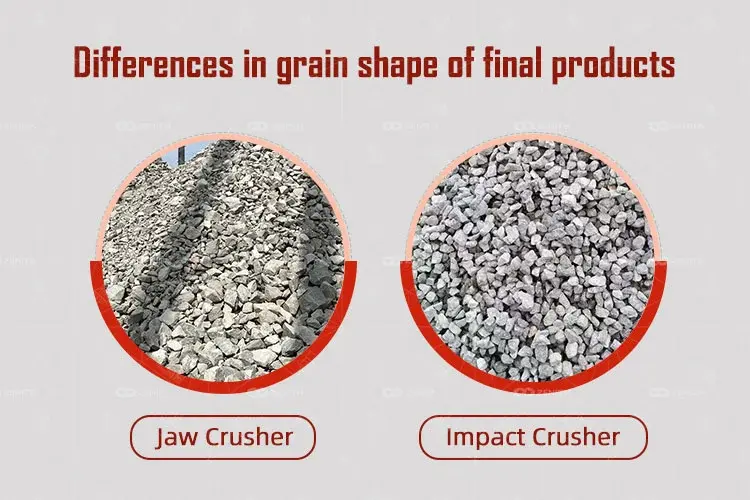
The maintenance costs of jaw crushers are relatively low. The main wear parts of the jaw crusher are the jaw plates. These jaw plates can be replaced every 6 - 24 months, depending on the operating conditions and the type of material being crushed. The cost of replacing a set of jaw plates is typically between 30,000 - 80,000 yuan. The simple structure of the jaw crusher also makes it easy to access and maintain the components. The maintenance costs of impact crushers are relatively high. The hammers or blow bars on the rotor are the main wear parts. These wear parts need to be replaced more frequently, typically every 2 - 6 months. The cost of replacing a set of blow bars can range from 150,000 - 400,000 yuan. In addition, the complex structure of the impact crusher requires more skilled maintenance personnel and more frequent inspections.
It is generally more budget - friendly. The initial investment for a jaw crusher typically ranges from 100,000 - 2,000,000 yuan. They are 30 - 50% cheaper than impact crushers with the same capacity. This cost advantage makes jaw crushers a popular choice for small - to - medium - sized operations or for projects with a limited budget. The simple structure and relatively low - tech manufacturing process of jaw crushers contribute to their lower cost. They do not require complex components such as high - speed rotors and multiple impact aprons.
It has a higher initial investment. The cost of an impact crusher typically ranges from 250,000 - 4,000,000 yuan. The higher price is justified by the complex engineering and the use of wear - resistant alloys in the construction of the crusher. The ability to produce high - quality aggregates with a good particle shape also adds to the value of the impact crusher. Despite the higher initial cost, the impact crusher can provide long - term benefits in terms of product quality and market competitiveness. In applications where high - quality aggregates are required, the investment in an impact crusher can be well - worth it.
It operates with relatively low vibration. The vibration level is typically less than 5 mm/s RMS (Root Mean Square). This low - vibration operation allows the jaw crusher to be installed on a basic concrete foundation. The simple and stable structure of the jaw crusher contributes to its low - vibration performance. The low - vibration operation reduces the stress on the crusher components and the foundation. It also results in less noise and a more comfortable working environment. In addition, the low - vibration operation can improve the reliability and longevity of the crusher.
It generates relatively high vibration during operation. The vibration level can reach up to 10 mm/s RMS. This high - vibration operation requires a reinforced foundation with anti - vibration pads. The high - speed rotation of the rotor and the impact of the material on the crusher components are the main causes of the high vibration. The high vibration can cause problems such as loosening of the crusher components and damage to the foundation. To address these issues, a reinforced foundation with anti - vibration pads is required. Regular maintenance and inspection of the crusher components are also necessary to ensure the stable operation of the impact crusher.
Jaw crushers generate a moderate amount of dust. The design of the crushing chamber helps to contain the dust to some extent. However, during the crushing process, especially when the material is dry, dust can still be generated. Some jaw crushers are equipped with dust - suppression systems, such as water sprays, to reduce the dust emissions. In addition to water sprays, enclosing the crushing chamber and using dust collectors can also effectively reduce the dust emissions from the jaw crusher. Impact crushers generate a relatively high amount of dust. The high - speed impact of the material on the impact aprons and the rotor can cause a large amount of dust to be generated. To control the dust emissions, impact crushers usually require the installation of baghouses or water spray systems. The high - volume dust generated by the impact crusher can be a challenge to control. The baghouses need to be properly maintained to ensure their efficiency, and the water spray systems need to be adjusted according to the operating conditions.
The noise levels of jaw crushers are typically in the range of 80 - 95 dB(A). The low - speed operation and the simple structure of the jaw crusher result in relatively low noise levels. However, in a large - scale operation with multiple jaw crushers, the cumulative noise can be a concern. The noise levels of impact crushers are in the range of 90 - 105 dB(A), approaching the noise level of a rock concert. In urban areas, sound - insulation measures need to be taken to reduce the impact of the noise on the surrounding environment.
It has basic automation features such as speed control and overload protection. These functions can ensure the stable operation of the crusher to a certain extent, reducing manual intervention. It can tolerate materials with a certain humidity. When the moisture content is ≤8%, it generally does not cause significant problems to its operation, and the risk of blockage is relatively low. This allows it to work normally in some relatively humid environments.
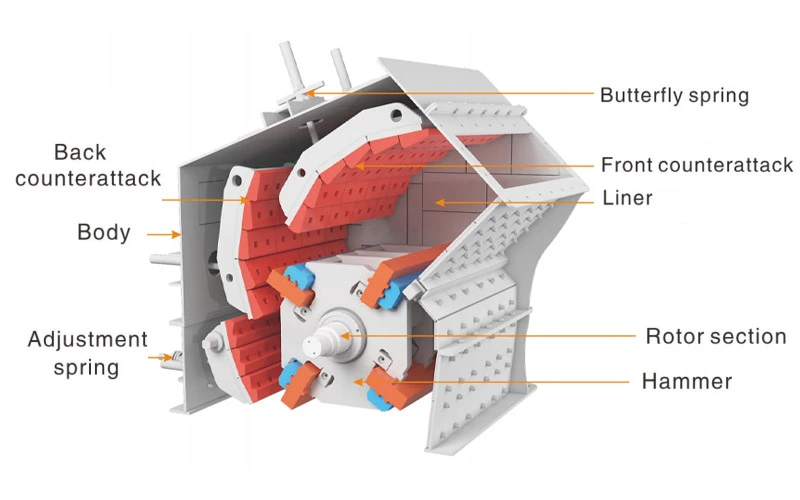
It requires more advanced control technologies, such as real - time rotor monitoring and impact apron adjustment. These functions can adjust the operating parameters of the crusher in real - time according to the characteristics of the material and the crushing situation to achieve the best crushing effect. It is sensitive to humidity. When the moisture content of the material is >5%, its performance will decline significantly. The material is likely to adhere to the blow bars and impact aprons, causing blockage and affecting production efficiency.
✅ You need to process ultra - hard materials. When dealing with materials with extremely high compressive strength, such as some special ores or hard rocks, the powerful compressive crushing ability of the jaw crusher can handle them.
✅ You require high primary crushing capacity. In large - scale production operations with high requirements for primary crushing capacity, the large feed opening and high throughput of the jaw crusher can meet the demand.
✅ You have a limited budget. If the project budget is limited, the relatively low initial investment and maintenance costs of the jaw crusher are important considerations.
✅ The working environment has high humidity. In a relatively humid environment, the humidity tolerance of the jaw crusher allows it to operate stably, reducing failures and downtime caused by humidity issues.
✅ You want to produce high - quality aggregates. For projects that require the production of high - quality, cubical - shaped aggregates, the impact crusher can meet the strict requirements for particle shape and quality.
✅ You need to process medium - soft materials. When the material has a moderate compressive strength and belongs to medium - soft materials, the impact crushing principle of the impact crusher can efficiently break it into the desired particle size.
✅ You value particle quality more than the initial cost. If you focus more on the quality and performance of the final product and are willing to pay for better particle shape and quality.